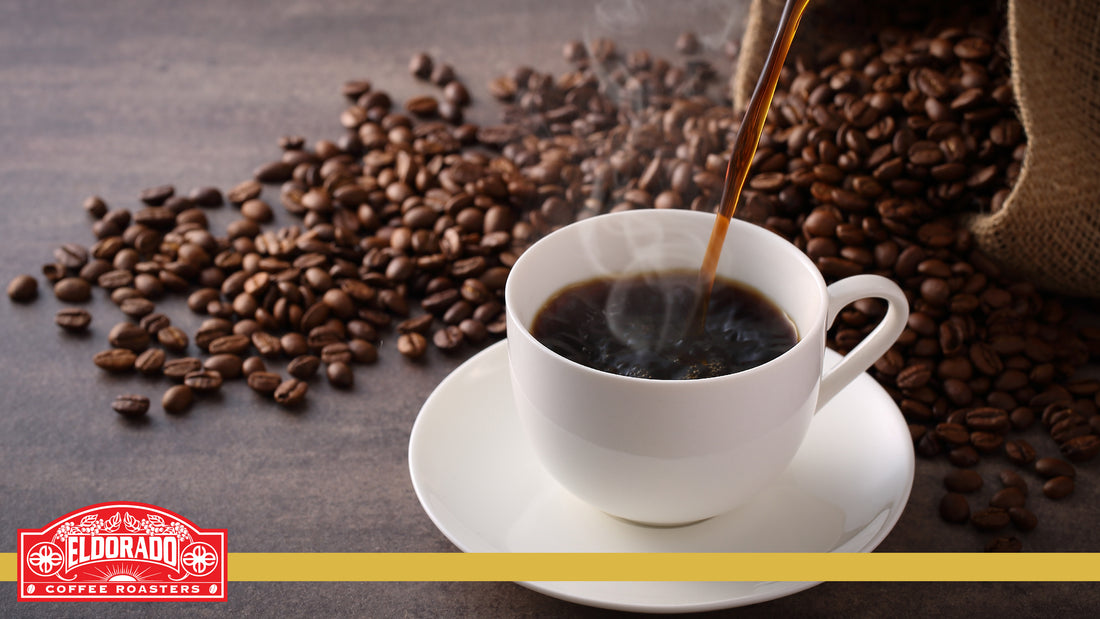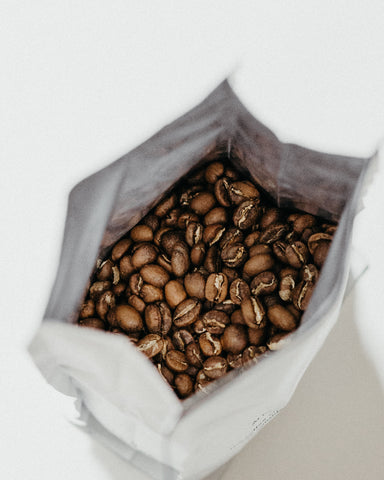
How To Make The Perfect Cup of Coffee At Home
Share
There’s something magical about waking up in the morning, sauntering to the kitchen, and going through the routine of making a cup of coffee. From the way the fragrance fills the air to the calming—almost meditative— steps that help relax your mind, to that first sip of brewed coffee, there’s nothing quite like it.
You want and deserve the best possible brew in your home. You want café-style coffee right in your kitchen—morning, noon, and night.
So today, we’re giving you the top Eldorado tips about how to make good coffee at home like a professional barista, down to the perfect ratio and filters to use.
1. It all boils down to the quality of the coffee.
Bad coffee beans = bad coffee. Quality coffee beans = a delicious, perfect cup of java. So you always want to start with good quality coffee beans.
But how do you know if you’re buying “quality” coffee?
At Eldorado, we define “quality” as coffee that is:
- Authentic: sourced from family-owned coffee plantations around the world
- Fresh: roasted at home to ensure freshness
- Ethical: grown and harvested in conditions healthy for the environment, the workers, and the coffee (check out the Smithsonian’s guide to buying ethical coffee)
(Gross fact: Did you know there could be mold in your coffee? Yuck. Get your coffee beans from local, family-owned companies like Eldorado to ensure freshness and health of the coffee you’re putting in your body.)
2. Grind matters.
If your coffee constantly tastes too weak, it could be that your grind is too coarse for your brewing method. For example, an espresso machine or aeropress requires a very fine grind, since the water is pushed through quickly. A drip machine or French press works best with a medium coarseness.
If your coffee tastes burnt or overdone, your grind might be too fine for the brew method. It’ll taste perfect if you adjust your grind even just a little bit!
Learn everything you need to know about grinding your coffee at home here.

3. Your coffee can go bad.
The perfect cup of coffee has the freshest possible coffee beans. Stale beans is a stale cup.
Coffee doesn’t stay fresh forever. Whole bean coffee goes bad after a few months, and ground coffee only lasts a few weeks. Learn how to keep your coffee fresh and tasting delicious. Quick tips: Store your coffee in an airtight container away from light, heat, and moisture.
Note: Ground coffee will expire faster than whole coffee beans. If you don’t drink a lot of coffee at home, you’ll likely want to store whole coffee beans to retain freshness for longer.
In general, whole bean coffee typically has a fresher flavor than pre-ground coffee. If you’re in search of the perfect cup, whole bean—like our Colombian Popayan whole bean coffee—might be your best solution. Find out the differences between ground and whole bean bags here.
4. Know your measurements.
In general, the perfect cup of coffee ratio is about 2 tablespoons of coffee per 6-8 ounces of water. To be on the safe side (and if you like your coffee strong and flavorful), we usually use 3 tablespoons per cup of coffee.
Remember that espresso calls for a finer grind. That’s because hot water is being pushed through the grinds at a faster rate with greater pressure, so you need a fine grind for proper extraction.
Your perfect cup of coffee ratio may be different than your friend’s or boss’s or barista’s, though. So you’ll want to experiment a little bit to find the ratio measurement that works best for your favorite brew.
5. The water quality and temperature will change the flavor.
If you’re not using filtered or spring water for your coffee, the bacteria and minerals in your water could actually interact with the coffee to cause an icky flavor. This can lead to a “funky” taste that overshadows your coffee’s naturally delicious notes.
Boiling is the key to how to make good coffee at home
Do you boil your water? Good! Boiling water helps ensure the majority of this bad-tasting gunk is removed.
But, you don’t want the water to be boiling when you make your coffee. The ideal temperature is below the boiling point, at about 195-205 degrees. If it’s 212 (boiling), it could actually chemically alter or damage the coffee beans.
If you boil the water, remove it the heat and let sit for about 30-60 seconds. This lets it cool down to the ideal temperature for brewing drip coffee.
6. The filter matters.
We’re giving you the details on how to make a cup of coffee step by step--down to even the filter you use!
Bargain coffee filters might actually brew bad tasting coffee. Experts have found that cheap coffee filters can leach chemicals and toxins into your cup that could ruin your coffee’s taste—and potentially harm your health.
We recommend using paper coffee filters that are not bleached, “oxygen-bleached,” or “dioxin-free” to avoid these toxins. The cleaner and purer the filter, the better. You don’t want to be drinking bleach with your morning java!
Check out this list of best coffee filters in 2019 with Food Shark Mania.

7. Let the coffee bloom first.
After the grounds are in your brewer and the water is at the right temperature, pour just a little bit of water over the grounds. The coffee should be wet but not saturated. The beans will puff up or “bloom.” Let sit for about 30 seconds to release the flavor of the coffee. Then pour the remainder of the water into your French press, pour-over, or other brewing method and brew as normal.
After you’ve poured the water in, let it sit for another 15-30 seconds before stirring. Then, use the back of a spoon to gently stir it to mix the coffee with the water.
This “bloom” releases the coffee flavor and aroma that will create the best possible taste and smell.
8. Brew for the exact amount of time.
Coffee brewing is a science as well as an art. You have to be specific about your measurement ratio and how long you brew for. We typically recommend 2 and a half to 4 minutes for pour-over or French press coffee. Too little time and your coffee will likely be weak or sour. If it’s brewing for too long, it might taste bitter or burnt.
For an Aeropress, 1-2 minutes should be sufficient sitting time. Check your Aeropress’s instructions for optimal timing.
Set a timer and stick to it. Now is not the time to go into another room to read a book. Wait patiently for your coffee if you want it to taste scrumptious.
9. Clean your equipment regularly.
Most people don’t think to clean their grinders or brewers because it “only has coffee in it.” But old coffee grounds can get lodged in your grinder and go rancid. Or leftover moist coffee spots can start to grow bacteria.
We recommend cleaning all of your coffee gear at least twice a month, if not once a week. This ensures there’s no expired gunk sitting in your machines, so you’re only getting the freshest and purest coffee poured into your mug.
To clean your coffee equipment, we recommend running a 1:1 white vinegar and water cleanser through your coffeemaker to naturally and effectively remove mineral deposits. Make sure you rinse a few times before use so you don’t get any vinegar in your cup. You can also use a specialty coffee equipment cleaner.
10. Add your sugar first.
If you’re a “milk and sugar” coffee fan, put the sugar in first. Sugar dissolves best in hot liquids. Putting the sugar in first will help it dissolve, so it won’t sit on the bottom. If you put cold milk in first, the coffee will lose some of its heat and make it harder for the sugar to dissolve.
But… you still want your cream to be cold when you add it in. In fact, adding cold cream will keep your coffee hot longer! It’s counterintuitive, but it’s true. The same is true of any milk alternative you use: pour it in cold, and your coffee will actually stay hot longer.
So: coffee, sugar, cold cream—in that order.
Is there an ideal ratio of sugar and cream to add? Nope, that’s up to you! Sweeter coffee, creamier coffee, or straight black depends entirely on your taste buds — so keep experimenting.
11. Try different coffee recipes.
The perfect cup is one that changes every day, right? One day you want black coffee and the next you’re dying for a sweet latte. So, try out different flavors, beans, and brew styles to discover what tickles your taste buds!
Get some of our favorite coffee recipes here:
- 6 Fall-Inspired Coffee Recipes To Try At Home
- 8 Winter Coffee Ideas To Get In The Spirit Of The Season
- 6 Deliciously Creative Cold Brew Coffee Recipes
How do you make good coffee at home? What’s your favorite brew? Contact us with your tips! We’re constantly experimenting with brews, and we want your input!
